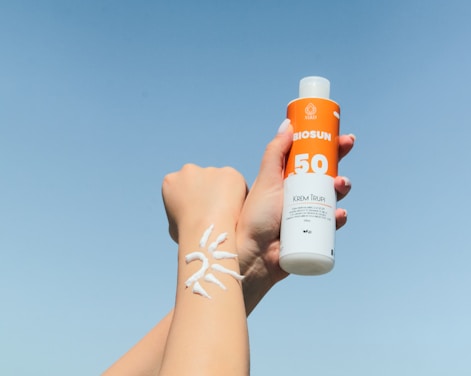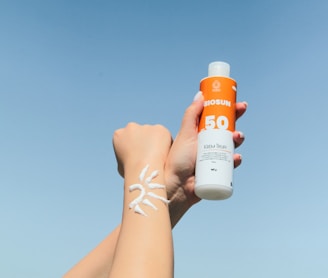Sunscreen Myths and Facts you should know about
You are aware that the one item in your skincare routine that you should use all year round is sunscreen. Wearing SPF is important for preventing skin cancer and symptoms of aging, whether you're sitting indoors or at the beach, as your mom, dermatologist, and favorite beauty editors have repeatedly told you. However, it becomes almost impossible to distinguish sunscreen facts from misconceptions. To dispel five of the most widespread misconceptions about sunscreen, we spoke with skincare professionals.
SKIN CARE
3 min read
Sunscreen Myths and Facts You Should Know
You are aware that the one item in your skincare routine that you should use all year round is sunscreen. Wearing SPF is important for preventing skin cancer and symptoms of aging, whether you're sitting indoors or at the beach, as your mom, dermatologist, and favorite beauty editors have repeatedly told you. However, it becomes almost impossible to distinguish sunscreen facts from misconceptions due to the abundance of contradictory and misleading information regarding sunscreen and skin cancer. To dispel five of the most widespread misconceptions about sunscreen, we spoke with skincare professionals.
For important sunscreen information and myths debunked by leading dermatologists, keep reading.
The Facts
The most deadly type of skin cancer, melanoma, is expected to strike roughly 100,000 Americans in 2023 and claim the lives of nearly 8,000 people, according to the American Cancer Society. Although alarming, that data is not conclusive. If you use sunscreen correctly and with the appropriate SPF, it can significantly reduce your chance of acquiring melanoma and other forms of skin cancer. Many people are nervous about the substances found in sunscreen lotions, though.
The Myths
Myth 1: Better protection is indicated by a higher SPF
It is not that easy to answer. UVA rays can also harm skin, but SPF measures protection against UVB rays, which are notorious for producing sunburns in the summer.
A protection level of 2 offers roughly 50%, SPF 15 - 93%, SPF 30 - 97%, SPF 50 - 98%, and SPF 100 - 99%. Thus, outrageously high SPF values are not really necessary to provide UVB protection; an SPF of 30 or above offers excellent UV protection. It is not really possible to get 100% UV protection with commercially available sunscreen formulas." Furthermore, the FDA discovered that not all sunscreens with high SPFs provide the same degree of ultraviolet A (UVA) protection. On the other hand, excessive UVA exposure raises the risk of skin cancer and aging symptoms. Thus, you should continue to use it even if the only SPF 100 you have in your medicine cabinet.
Myth #2: You can get ample protection just by using sunscreen.
Yes, sunscreen will significantly lower your risk of developing skin cancer, but application technique is just as crucial. To be effective, SPF must be applied in the proper dosage, which is around a teaspoon for each leg and a teaspoon for the face. Other sun protection considerations include wearing a wide-brimmed hat, sunglasses, and remaining in shadier regions.
Myth #3: You don't need sunscreen inside or on cloudy days.
This is where finding a sunscreen that protects against UVA and UVB rays comes into play. UVA photons have longer wavelengths and can cause skin damage regardless of the weather or whether you're sitting in front of your living room window.UVB rays are traditionally thought to be responsible for sunburns in the summer. In truth, UVA photons, which have longer wavelengths and can penetrate clouds, are what cause solar damage regardless of the season. UVA rays, by analogy, can likewise pass through windows.
Myth #4: Physical sunscreens are superior to chemical sunscreens.
While the FDA has discovered that six common active chemicals in chemical sunscreens permeate into the skin, the agency has stated that more research is needed before they can be deemed safe. Physical sunscreens, on the other hand, are less prone to irritate the skin.
Physical sunscreens, such as zinc oxide and titanium dioxide, are minerals that cannot cause a skin reaction. Chemical sunscreens, on the other hand, convert light energy into heat on the skin's surface." The heat can cause inflammation, leading to the production of aberrant pigmentation on the skin.
Physical sunscreens also have the added benefit of blocking non-UV radiation such as blue and infrared. They also do not penetrate the skin. It has been scientifically proved that nanoparticle physical sunscreens are not systemically absorbed, but chemical sunscreens have been demonstrated to be systemically absorbed.
Myth #5: Dark skin tones are immune to skin cancer.
Skin cancer can occur if you have skin. Period. However, it can seem differently in different skin tones. Some skin types have a disproportionate distribution of melanoma locales. "For example, Black skin is more prone than the general population to develop acral melanoma (on the palms or soles).
Although darker skin may not burn as quickly, the detrimental consequences of UV radiation in the form of hyperpigmentation, wrinkles, and cancer do occur.
Keep reading TheStyleBuzz for latest trends and updates


Contacts
asharma@thestylebuzz.com
Subscribe to our newsletter
TheStyleBuzz offers informative content of a general nature. However, it is important to note that this information should not be considered as a substitute for professional medical advice, diagnosis, or treatment. TheStyleBuzz is committed to providing accurate and reliable information, but it is important to use your own discretion and seek professional advice when necessary.
